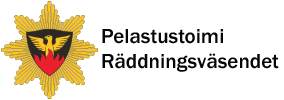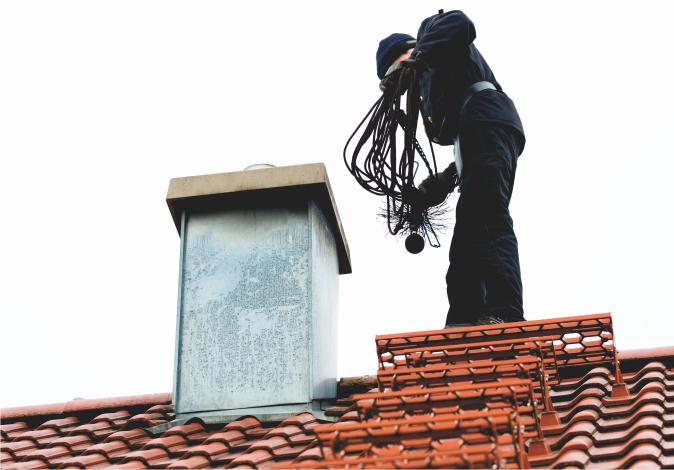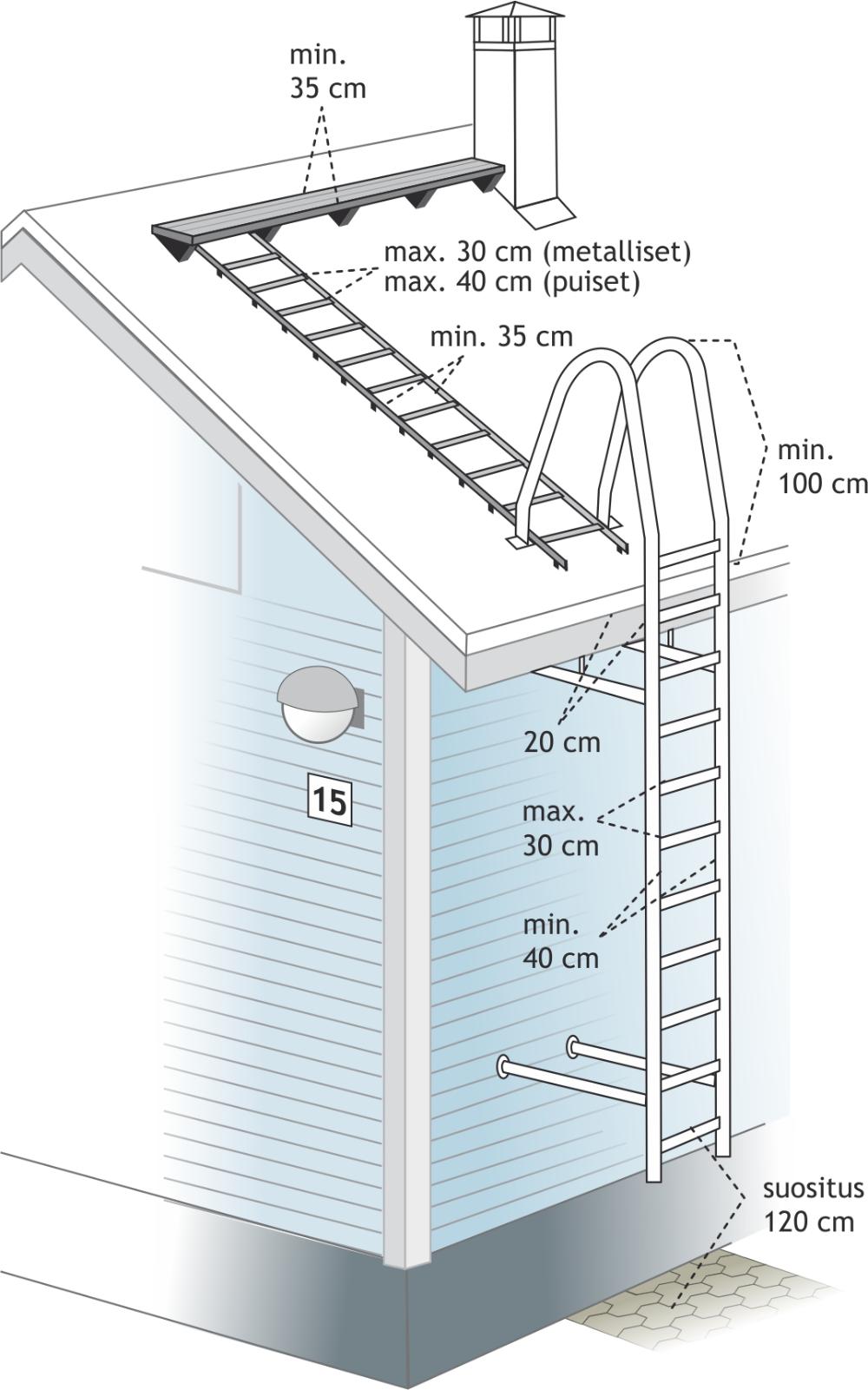

Chimney sweeping
Chimney sweeping is part of fire safety
The purpose of chimney sweeping is to clean combustion residues from fireplaces and flues and thus prevent chimney fires. Sweeping also includes inspecting the condition of fireplaces and flues visually to detect in advance any defects that cause a fire risk. In addition to fire safety, regular sweeping is also necessary to ensure that the fireplace gives a good heating performance and that there is sufficient draft in the flue.
The rescue services’ statistics indicate that around one third of fires in fireplaces and flues, or on average three hundred every year, are chimney fires. Additionally, less than a hundred fires each year are caused by damaged fireplaces and flues. Residential buildings account for 74% and holiday houses for 25% of properties where sweeping needs to be carried out. More than one million properties need sweeping every year.
Chimney sweeping services
The rescue departments no longer have an obligation to provide chimney sweeping services in their regions. Chimney sweeping entrepreneurs may offer their services anywhere in the country without geographical restrictions. The owner and occupant of the building can book the chimney sweeping company of their choice to perform its services.
As the rescue departments no longer have an obligation to sweep chimneys, no price regulation applies to these services. The entrepreneurs price their own services, and the prices and pricing criteria of chimney sweeping vary from one company to the next. It is a good idea to check the price, or at least the criteria for determining the price, with the entrepreneur as you book the service. Under legislation on doorstep and distance sales, a chimney sweeping company must inform the customer of the total price of the service, or at least the pricing criteria, before a contract is made. Chimney sweeps may give the price of sweeping one fireplace and flue as an example in their advertisements.
As before, only qualified chimney sweeps may perform this work. A chimney sweep refers to a person who has completed either a Further qualification for Chimneysweeps or the competence area of chimney sweeping in the Further qualification in Building Maintenance Technology. Chimney sweeps who offer and market chimney sweeping services are assumed to have the necessary qualification.

Tasks of a chimney sweep
The chimney sweep cleans and checks the fireplace and flue as well as their components. After preparative tasks, the chimney sweep cleans the fireplaces and flues and also assesses their condition, the adequacy of safety distances, the airtightness of ash pits and the operation of dampers. The chimney sweeper does not need to use special tools for assessing the condition of the fireplace and flue. Good chimney sweeping practices must be followed in this work.
Chimney sweeping certificate
The sweep always issues a chimney sweeping certificate. You should keep this certificate until your chimney is swept the next time. If the rescue authority comes to inspect your property, you can use the chimney sweeping certificate to prove that sweeping has been carried out appropriately in the building. The observations recorded by the chimney sweep on the certificate also make it possible to monitor and assess the development of fireplace and flue condition.
The chimney sweeping certificate is not the same as the invoice. In addition to the name of the person who carried out the work and the address of the property, the certificate shows the date on which the sweeping was carried out and the actions taken as well as any defects and shortcomings detected by the chimney sweep. In particular, the chimney sweep must record any defects and shortcomings that cause a fire risk so clearly that the owner and occupier of the building can correct them as necessary. If a chimney sweep has detected a defect or shortcoming in the fireplace or flue that may cause a fire risk when the fireplace is used, they must also notify the rescue department of the region in writing of their observation.
The rescue departments guide and advise properties in fire safety. They also supervise properties to ensure that the obligation to carry out chimney sweeping is met. The Rescue Act does not contain provisions on oversight of chimney sweeping companies or services. The Consumer Protection Act and the Competition Act apply to the provision and marketing of chimney sweeping services, as they do to other services provided in the customer's home.
As the owner and occupant of the building, you are responsible for having its fireplaces swept regularly.
I need my chimney swept – what should I do?
In earlier times when the rescue departments were responsible for chimney sweeping, households received a sweeping notification in their letterboxes. This has been replaced by marketing leaflets of chimney sweeping entrepreneurs. You have to book a chimney sweep if you wish them to visit your property. This means that the time and date suggested in the advertising leaflet must always be confirmed. You should also ask how much the sweeping will cost. Similarly to other advertising, advertising leaflets about chimney sweeping are not put in mailboxes which indicate that the owner does not want free newspapers and advertising material. In this case, the owner or occupier of the building must be particularly active and use their initiative to book a chimney sweep.

Look after roof safety
Keeping ladders, parts of roof walkways and roof safety equipment in such a condition that chimney sweeping can be carried out safely is an elemental part of the obligation to have the chimneys swept. Chimney sweeps work round the year, which is why the ladders must also be safe in slippery winter conditions. As this is about the occupational safety of chimney sweeps, the safety requirements apply to all buildings, including old ones. If there is no fixed ladder or it is in poor condition, sweeping the chimney may not be possible.
The coronavirus epidemic and efforts to prevent the spread of infections require new types of practices in chimney sweeping, both from chimney sweeps and their customers, as sweeping mainly takes place in people's homes and residential buildings. It is a good idea to agree with the chimney sweep in advance on what safety measures and actions are needed in each case.
Remember that chimney sweeping is part of fire safety.
Sweeping interval - how often should chimneys be swept?
The old provisions on sweeping intervals remain in force. The principle is that fireplaces and chimneys must be swept often enough, depending on how much the fireplace is used, its structure and the fuel used. The legislation lays down the minimum intervals of chimney sweeping in residential buildings, however: the chimney must be swept at least once a year if the building is used year round, and at least once every three years if the building is a holiday house, such as a summer cottage. In the legislation on chimney sweeping intervals, the division into buildings used round the year and holiday houses now refers to how much the building and its fireplaces are used, rather than to the purpose of the building. In non-residential buildings, the chimneys must be swept as required. If a fireplace and flue are not used, sweeping is not necessary.
Read more:
the Rescue Act
National federation of the chimney sweeping sector (in Finnish)


